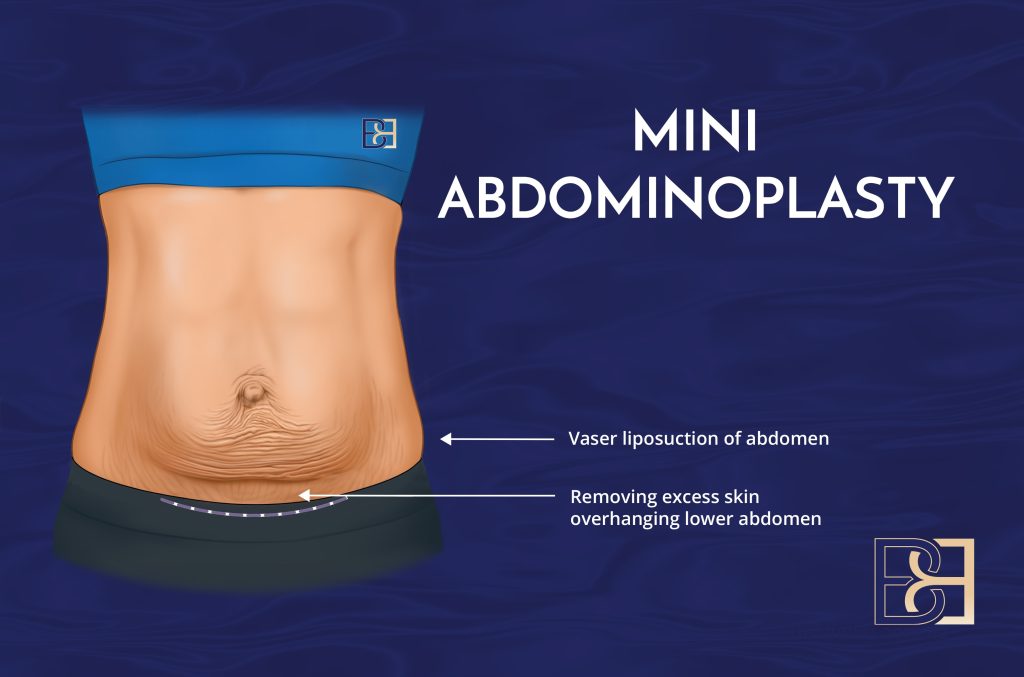Mini Abdominoplasty with VASER Suction-Assisted Lipectomy is a surgical procedure that may be considered for individuals with excess skin and fatty tissue in the lower abdomen, particularly below the belly button. This condition commonly occurs after pregnancy or significant weight loss, when the skin and soft tissues have stretched and may not return to their previous state.
While healthy lifestyle choices such as diet and exercise support overall wellness, they generally do not improve lax or redundant skin. In some cases, patients may notice an overhang of skin over a previous Cesarean section scar.
In addition to excess skin and fat, some individuals may also experience a condition called diastasis recti—separation of the rectus abdominis muscles. Studies suggest that more than half of women show signs of diastasis recti six weeks postpartum, with some continuing to experience it one year or more after delivery.
Mini VASER lipo-abdominoplasty combines suction-assisted liposuction with a mini abdominoplasty. This approach may be suitable for selected patients based on a thorough clinical assessment and individual treatment goals.
Book Online Now
Download our short guide: “11 Important Abdominoplasty Techniques That you Need to Know”
Who May Be a Candidate?
Mini abdominoplasty with suction-assisted liposuction is typically performed on individuals with a small amount of loose skin and fat isolated to the lower abdominal region. Many candidates are women who have given birth and do not have significant muscle separation. It is sometimes performed in patients whose skin hangs over a C-section scar.
This procedure may be considered for individuals who:
- Are near their ideal weight and maintain a stable lifestyle
- Have mild to moderate excess skin or fatty tissue in the lower abdomen
- Have no, or only minimal, diastasis recti
It is important to note that while some tissue is removed during surgery, mini abdominoplasty is not a weight-loss procedure.
Procedure Overview
Dr. Beldholm uses a combination of VASER liposuction (ultrasound-assisted lipolysis) and surgical skin excision to contour the lower abdomen. The procedure generally targets the area below the belly button, removing a segment of loose skin and underlying fat. Liposuction may also be performed on the upper abdomen and flanks, depending on the individual case.
The procedure typically takes 2 to 3 hours and, in some cases, may be performed as a day-only hospital procedure.
Potential Outcomes and Considerations
Mini VASER lipo-abdominoplasty is a less extensive alternative to full abdominoplasty and may involve a shorter recovery period. In some cases, removal of skin may incidentally reduce the appearance of stretch marks located in the excised area, though this is not guaranteed and not a primary aim of the procedure.
As with any surgery, this procedure carries potential risks, including but not limited to:
- Bleeding
- Infection
- Seroma (fluid accumulation)
- Scarring
- Changes in skin sensation
- Unfavorable cosmetic result
A consultation with a qualified specialist is essential to determine whether this procedure is appropriate based on your medical history, examination, and expectations.
Recovery and Aftercare
Patients are provided with comprehensive post-operative care instructions. While recovery from mini abdominoplasty is typically shorter than full abdominoplasty, rest and limited physical activity are still required. The timeline for return to work and normal activities varies between individuals and will be discussed during your consultation.
Learn More
A personalised consultation is the best way to explore whether mini VASER lipo-abdominoplasty is suitable for you. Every patient’s anatomy and goals are different, and a thorough clinical assessment is required to determine the most appropriate treatment plan.
References
- Nahabedian, M. Y. (2007). Management of abdominal skin redundancy. Aesthetic Surgery Journal, 27(6), 594–599.
- Benjamin, D. R., van de Water, A. T., & Peiris, C. L. (2014). Effects of exercise on diastasis of the rectus abdominis muscle in the antenatal and postnatal periods: A systematic review. Physiotherapy, 100(1), 1–8.
- Mommers, E. H. H., Ponten, J. E. H., Al Omar, A. K., & van der Hulst, R. R. W. J. (2018). The effectiveness of abdominoplasty on quality of life, psychological distress, and eating disorder symptoms in post-bariatric surgery patients. Aesthetic Plastic Surgery, 42(6), 1787–1795.
- American Osteopathic College of Dermatology. Striae Distensae (Stretch Marks).
- Repta, R. (2016). Mini-abdominoplasty. Clinics in Plastic Surgery, 43(3), 541–548.
